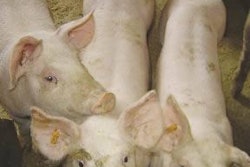
Money made the headlines when an international group of pig-industry economists reported recently on their latest comparison of production costs between countries. However, an equally practical aspect from a producer viewpoint may have been that they also compared efficiency in terms of herd-level measures such as labour utilisation and feed conversion rates.
The group is called InterPig and it was reporting on a Pig Cost of Production comparison for the year 2007, covering the member states of the European Union and the transatlantic competition from Brazil, Canada and the USA.
By the assessment of these economists, the average cost of producing pigs in the EU countries in 2007 showed an annual increase of 12%. Virtually all the extra was down to record-high prices for feed ingredients, of course. Even so, the total cost rise was found to have varied quite widely from one European country to the next (Table 1 ). At the top there had been annual increases of 19% for Belgium, 16% for the Netherlands and 12% each for Britain and France. Lower down the scale, costs were up by 11% in Spain and Sweden, 9% in Germany, 8% in Ireland and 5% in Austria.
A commentary on these findings by Tony Fowler of AHDB Meat Services in the UK* has pointed to higher rises in the USA (over 12% in dollar terms), Canada (over 22%) and Brazil (18%), while including a reminder that the total cost per kilogram of carcase weight in each of these countries was still lower than in the European Union. He also repeated an earlier caution about comparing Italy’s costs with those for the rest of Europe because of the significantly higher Italian slaughter weight associated with prosciutto ham production.
How countries compare
By Mr Fowler’s analysis, the members of the European Union in the high-cost category remain Italy, Britain, Sweden and Austria. Relatively low British carcase weights contribute to apparently higher national costs, he adds, as the total cost per pig is divided by fewer kilograms.
The medium-cost category for EU members comprises Germany, Ireland and Spain, he continues. But they differ in cost components. For example, whereas Ireland and Spain have some of the highest feed costs in the European Union, Germany’s feed costs rate second-lowest of all member states.
The low-cost countries in Europe are France, Belgium, the Netherlands, as Table 2 confirms. Says Mr Fowler, countries in this cost band are characterised by a combination of superior technical performance and low feed prices.
His analysis makes clear that feed costs rose in 2007 at rates ranging from 10% for the USA to 44% for Canada. Across the European Union the average uplift was 21%. Brazil’s feed cost rose by 17% during the year, according to this calculation.
More productive labour
Labour inputs receive a detailed commentary in his report. The average for EU members in 2007 as in 2006 was 0.99 hours per finished pig produced, he explains. How the European countries compared with each other is indicated by Table 3 . Improved labour productivity for most of them over the past five years is attributed largely to the fact of more pigs per sow/year leading to a decline in hours/year. A 2% improvement in the number of pigs finished per sow helped the EU average labour cost per pig fall by 1% from 2006 to 2007.
Brazil’s labour costs per hour were the lowest of any country in the InterPig survey. They therefore continued to give the lowest cost of labour per kilogram produced, despite the Brazilian number of hours per finished pig being over three times the EU average.
Other physical parameters are compared in Table 3 for a range of countries in Europe and North America. Again the comparisons need to be approached carefully due to the differences between countries such as for slaughter weights, but the Danish and Dutch results stand out in terms of efficiency.
A closer look at production cost developments in the Netherlands has been undertaken by Dutch economics institute LEI on behalf of the national Ministry of Agriculture, Nature and Food Quality and the Product Boards for Livestock, Meat and Eggs (PVE). With LEI economist Robert Hoste being a prominent member of InterPig, the assessment overlaps what the group had to say about the cost comparison between countries for 2007.
A new report co-authored by Mr Hoste with Linda Puister has been issued with the Dutch-language title of Productiekosten van Varkens: een internationale vergelijking (for details, see www.lei.dlo.nl/publicaties). It adds to the InterPig comparison an assessment of the cost increase per country until the year 2013 resulting from social societal demands on production.
In 2007, producing each kilogram of slaughter weight on a Dutch pig unit was reckoned to have cost €1.40 (up to €1.47 when adding value-added tax) and 52% was due to feed expenses (Figure 1 ). However, some pig producers nationally might be able to cut their cost by improving labour productivity. The report says this factor explains part of the considerable variation in production costs between farms in the Netherlands. There is a close relationship between labour productivity and production costs in both sow herds and finishing units.
Moreover, Dutch units that wanted to expand would need to have so-called production rights costing the equivalent of €0.05 per kilogram of pig produced. When InterPig compared European countries for their 2007 pig-producing costs the result was shown excluding value-added tax and production rights. On that basis, the Netherlands and Denmark were the cheapest pig producers. But the LEI investigation has concluded that adding the costs of production rights would show the Dutch industry to be at a cost disadvantage compared with the Danes.
Since 2007, say the authors, there has been a clear increase in production costs in the Netherlands, illustrated by a 56% rise in price for the average pig feed between July 2006 and June 2008. A cost per kilogram calculation for Dutch pork at mid-2008 feed prices would be €1.58 or around 25% more than calculated for 2006.
The investigators contend that the rise in production costs caused by the increased feed price was generally higher in other countries than in the Netherlands, because Dutch units had a better feed conversion rate for grow-finish pigs. Figure 2 shows the feed conversion rates indicated for 2007 in the different countries, found by dividing the total feed used for sows, piglets growing-finishing by the liveweight of pigs sent for slaughter.
Another contention from the report is that costs vary from country to country in Europe because of differences in regulations (Figures 3 and 4 ). Within the European Union there is said to be an inequality in government measures relating to environment, animal welfare, animal health, public health and spatial planning.
According to LEI analyses the environmental costs paid by pig producers in the Netherlands are likely to rise from around €0.11 per kilogram in 2007 to €0.13/kg in 2013 as a result of government policies on reducing ammonia emissions. In other countries of Europe the equivalent costs were only between €0-0.05/kg, but France, Germany and Denmark by 2013 can expect increases to a level of €0.05-0.06/kg.
Animal welfare measures in the Netherlands are predicted to incur costs rising from €0.02/kg in 2007 to €0.05/kg in 2013. In Germany, by contrast, these additional costs for welfare measures are forecast to rise only to €0.01/kg and in other countries they will probably stay at almost zero. There are also costs relating to public health measures and to spatial planning that need to be taken into account. The overall figure suggested by the LEI authors for the extra costs due to policy measures in the Netherlands in 2007 was €0.20/kg. This compared with €0.08 in Denmark and Spain, around €0.07 in Germany and €0.06 in France and Poland.
"The costs of policy measures in Europe will further increase in the coming years," the Dutch report insists. In net terms, their cost in the Netherlands until 2013 will rise by €0.06 to total €0.26/kg. The predictions for Germany and Denmark are an increase to €0.12/kg and for France to rise to €0.08/kg.
It will mean the all-in production costs in the Netherlands in 2013 moving closer to €1.58/kg, says LEI, whereas France will be around €1.49/kg and Denmark €1.44/kg.





.jpg?auto=format%2Ccompress&fit=crop&h=167&q=70&w=250)











